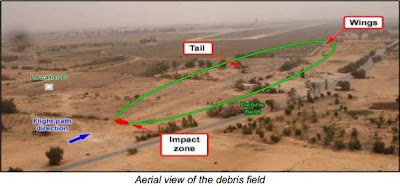 Libya's Civil Aviation Authority has released its final report on the crash of the Afriqiyah Airlines (8U) Airbus A330-200 (MSN 1024 | 5A-ONG) operating as flight 8U772 from Johannesburg, South Africa to Tripoli, Libya, which crashed on approach into Tripoli International Airport in May 2010. According to their findings, air crash investigators have blamed "the limited coordination and cooperation between the two crew members" exacerbated by fatigue and coupled with the effects of somatogravic illusions (i.e. an optical illusion that can result in spatial disorientation) as the mitigating factors in the crash.
Libya's Civil Aviation Authority has released its final report on the crash of the Afriqiyah Airlines (8U) Airbus A330-200 (MSN 1024 | 5A-ONG) operating as flight 8U772 from Johannesburg, South Africa to Tripoli, Libya, which crashed on approach into Tripoli International Airport in May 2010. According to their findings, air crash investigators have blamed "the limited coordination and cooperation between the two crew members" exacerbated by fatigue and coupled with the effects of somatogravic illusions (i.e. an optical illusion that can result in spatial disorientation) as the mitigating factors in the crash.Backround
 |
| The ill-fated Afriqiyah Airlines (8U) A330 |
On 12 May 2010, Flight 8U771 had on board three cockpit crew (who had flown the exact same flight on the exact same aircraft on 28 April 2010), eight cabin crew, and 93 passengers, with 50'000 Kgs of fuel during its take-off roll.
After an uneventful flight from Johannesburg, the crew, during final approach towards runway 09 at Tripoli International Airport, announced a go-around and initiated the Missed Approach Procedure, with the knowledge and confirmation of Tripoli tower. Prior to the go-around, the accident crew had received information from an aircraft that had landed before them, warning them about fog patches during
short finals.
"The captain then instructed the co-pilot to execute a go-around, after which he informed the Tower controller. The aircraft began to climb, reaching an altitude of 450 feet above ground level. The Airbus then nosed down, causing the captain to take priority over the flight controls by pushing on priority button and the aircraft was fully under the captain’s control who applied a sharp nose down input. The captain did not verbally state that he was taking control. He applied a pitch-up and a pitch-down input on his stick."
However, shortly before touchdown, at 04h01Z, the aircraft descended
dramatically and impacted the ground about 1'200 meters short of runway
09's threshold and 150 meters right of the runway centre line.
The impact and post impact fire
completely destroyed the Aircraft with only one passenger in seat 12D, a
boy, surviving the crash, albeit with serious injuries.
Aftermath
 |
| Afriqiyah 771 Crash Tripoli - AFP |
Causes
 |
| (Libyan Civil Aviation Authority) |
According to the Report, the most likely causes for the crash were:
A final approach carried out in common managed guidance mode should have relieved the crew of their tasks. The limited coordination and cooperation between the two crew members, especially
the change into Vertical Selected Guidance mode by the Pilot flying,
probably led to a lack of a common action plan.
The lack of
feedback from the 28 April 2010 flight, flown by the same crew on the
same aircraft, did not allow them to anticipate the potential
risks associated with managing non-precision approaches.
The pilots’
performance was likely impaired because of fatigue, but the extent of
their impairment and the degree to which it contributed to the
performance deficiencies that occurred during the flight cannot be
conclusively determined. During the go-around, the crew was
surprised not to acquire visual references.
On one hand, the crew feared exceeding the aircraft’s speed limits in relation to its configuration, and on the other hand they were feeling the effects of somatogravic illusion due to the aircraft's
acceleration. This probably explains the aircraft handling
inputs, mainly nose-down inputs, applied during the go-around. These inputs were not consistent with what is expected in this
flight phase. The degraded Cockpit/Crew Resource Management - CRM did not make it possible for either crew member to identify and recover from the situation
before the collision with the ground, even when the TAWS (Terrain Awareness and Warning Systems)
warnings were activated close to the ground.
Based on elements from the investigation, the accident resulted from:
- The lack of common action plan during the approach and a final approach continued below the Minimum Descent Altitude (MDA), without ground visual reference acquired.
- The inappropriate application of flight control inputs during a go-around and on the activation of TAWS (Terrain Awareness and Warning Systems) warnings,
- The lack of monitoring and controlling of the flight path.
These events can be explained by the following factors:
- Limited CRM (Cockpit/Crew Resource Management) on approach that degraded during the missed approach. This degradation was probably amplified by numerous radio-communications during the final approach and the crew’s state of fatigue,
- Aircraft control inputs typical in the occurrence of somatogravic perceptual illusions,
- Inappropriate systematic analysis of flight data and feedback mechanisms at Afriqiyah Airways.
- Non adherence to the company operations manual, standard operational procedures and standard terminology.
- Weather available to the crew did not reflect the actual weather situation in the final approach segment at Tripoli International Airport.
- Inadequacy of training received by the crew,
- Occupancy of tower frequency by both air and ground movements control.



